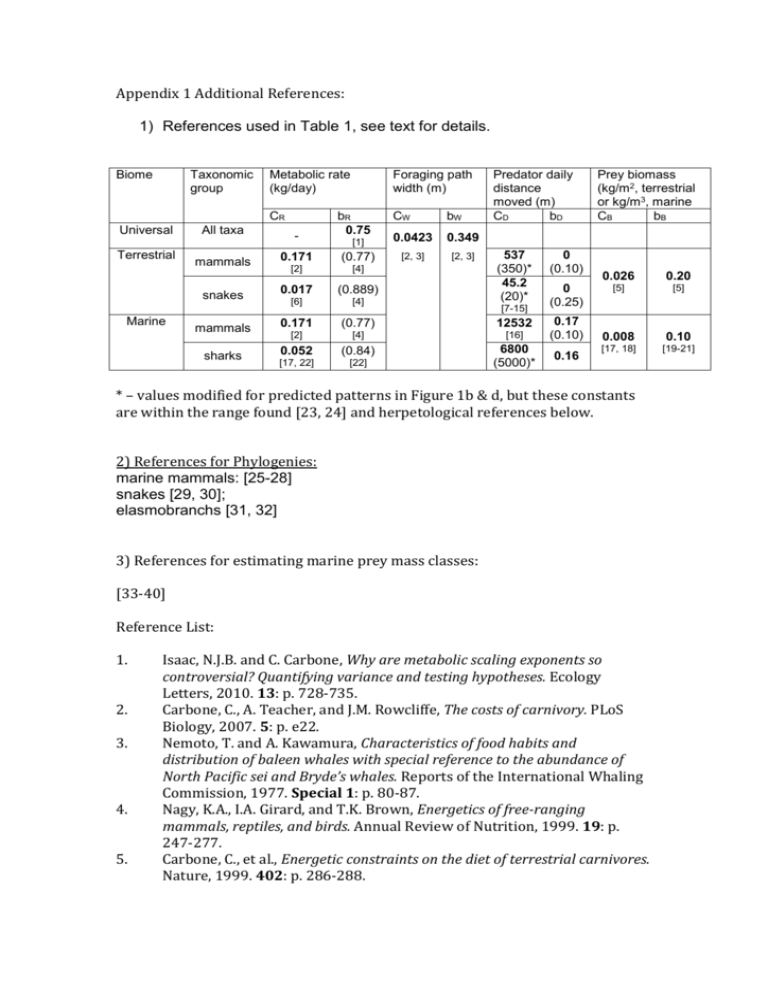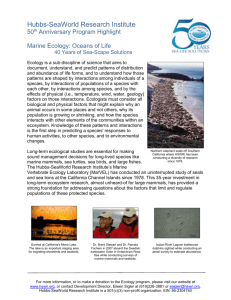ele12375-sup-0001-Appendix-S1
advertisement

Appendix 1 Additional References: 1) References used in Table 1, see text for details. Biome Taxonomic group Universal Terrestrial Marine All taxa Metabolic rate (kg/day) Foraging path width (m) CR CW bW [1] 0.0423 0.349 [2, 3] [2, 3] - bR 0.75 Predator daily distance moved (m) CD bD mammals 0.171 (0.77) [2] [4] snakes 0.017 (0.889) [6] [4] 537 (350)* 45.2 (20)* mammals 0.171 (0.77) 12532 [2] [4] [16] sharks 0.052 (0.84) [17, 22] [22] 6800 (5000)* [7-15] 0 (0.10) 0 (0.25) 0.17 (0.10) 0.16 Prey biomass (kg/m2, terrestrial or kg/m3, marine CB bB 0.026 0.20 [5] [5] 0.008 0.10 [17, 18] [19-21] * – values modified for predicted patterns in Figure 1b & d, but these constants are within the range found [23, 24] and herpetological references below. 2) References for Phylogenies: marine mammals: [25-28] snakes [29, 30]; elasmobranchs [31, 32] 3) References for estimating marine prey mass classes: [33-40] Reference List: 1. 2. 3. 4. 5. Isaac, N.J.B. and C. Carbone, Why are metabolic scaling exponents so controversial? Quantifying variance and testing hypotheses. Ecology Letters, 2010. 13: p. 728-735. Carbone, C., A. Teacher, and J.M. Rowcliffe, The costs of carnivory. PLoS Biology, 2007. 5: p. e22. Nemoto, T. and A. Kawamura, Characteristics of food habits and distribution of baleen whales with special reference to the abundance of North Pacific sei and Bryde’s whales. Reports of the International Whaling Commission, 1977. Special 1: p. 80-87. Nagy, K.A., I.A. Girard, and T.K. Brown, Energetics of free-ranging mammals, reptiles, and birds. Annual Review of Nutrition, 1999. 19: p. 247-277. Carbone, C., et al., Energetic constraints on the diet of terrestrial carnivores. Nature, 1999. 402: p. 286-288. 6. 7. 8. 9. 10. 11. 12. 13. 14. 15. 16. 17. 18. 19. 20. 21. 22. Peters, R.H., The ecological implications of body size. 1983, Cambridge: Cambridge University Press. Gent, A.H. and I.F. Spellerberg, Movement rates of the smooth snake Coronella austriaca (Colubridae): a radio-telemetric study. Herpetological Journal, 1993. 3: p. 140-146. Secor, S.M., Ecological significance of movements and activity range for the sidewinder (Crotalus cerastes). Copeia, 1994. 1994: p. 631-645. Wilson, D., R. Heinsohn, and S. Legge, Age‐and sex‐related differences in the spatial ecology of a dichromatic tropical python (Morelia viridis). Australian Ecology, 2006. 31: p. 577-587. Lee, H.J., J.H. Lee, and D. Park, Habitat use and movement patterns of the viviparous aquatic snake (Oocatochus rufodorsatus) from Northeast Asia. Zoological Science, 2011. 28: p. 593-599. Plummer, M.V. and J.D. Congdon, Radiotelemetric study of activity and movements of racers (Coluber constrictor) associated with a Carolina bay in South Carolina. Copeia, 1994. 1994: p. 20-26. Beck, D.D., Ecology and energetics of three sympatric rattlesnake species in the Sonoran Desert. Journal of Herpetology, 1995. 29: p. 211-223. Keogh, J.S., J.K. Webb, and R. Shine, Spatial genetic analysis and long-term mark–recapture data demonstrate male-biased dispersal in a snake. Biology Letters, 2007. 3: p. 33-35. Webb, J.K. and R. Shine, A field study of spatial ecology and movements of a threatened snake species (Hoplocephalus bungaroides). Biological Conservation, 1997. 82: p. 203-217. Wasko, D.K. and M. Sasa, Activity patterns of a neotropical ambush predator: Spatial ecology of the Fer‐de‐lance (Bothrops asper, Serpentes: Viperidae) in Costa Rica. Biotropica, 2009. 41: p. 241-249. Hedenström, A., Scaling migration speed in animals that run, swim and fly. Journal of Zoology, 2003. 259: p. 155-160. Sims, D.W., Sieving a living: A review of the biology, ecology and conservation status of the plankton‐feeding basking shark (Cetorhinus maximus). Advances in Marine Biology, 2008. 54: p. 171-220. Motta, P.J., et al., Feeding anatomy, filter-feeding rate, and diet of whale sharks (Rhincodon typus) during surface ram filter feeding off the Yucatan Peninsula, Mexico. Zoology, 2010. 113: p. 199-212. Koslow, J.A., R.J. Kloser, and A. Williams, Pelagic biomass and community structure over the mid-continental slope off southeastern Australia based upon acoustic and midwater trawl sampling. Marine Ecology Progress Series, 1997. 146: p. 21-35. Jennings, S., et al., Global-scale predictions of community and ecosystem properties from simple ecological theory. Proceedings of the Royal Society B, 2008. 275: p. 1375-1383. Gasol, J.M., P.A. del Giorgio, and C.M. Duarte, Biomass distribution in marine planktonic communities. Limnology and Oceanography, 1997. 42: p. 1353-1363. Sims, D.W., Can threshold foraging responses of basking sharks be used to estimate their metabolic rate? Marine Ecology Progress Series, 2000. 200: p. 289-296. 23. 24. 25. 26. 27. 28. 29. 30. 31. 32. 33. 34. 35. 36. 37. 38. 39. Carbone, C., et al., How far do animals go? Determinants of day range in mammals. American Naturalist, 2006. 165: p. 290-297. Garland, T., The relation between maximal running speed and body mass in terrestrial mammals. Journal of Zoology, 1983. 199(2): p. 157-170. Bininda-Emonds, O.R.P., et al., The delayed rise of present-day mammals. Nature, 2007. 446: p. 507-512. Koepfli, K.P. and R.K. Wayne, Phylogenetic relationships of otters (Carnivora: Mustelidae) based on mitochondrial cytochrome b sequences. Journal of Zoology, 1998. 246: p. 401-416. Higdon, J.W., et al., Phylogeny and divergence of the pinnipeds (Carnivora: Mammalia) assessed using a multigene dataset. BMC Evolutionary Biology, 2007. 7: p. 216. Price, S.A., O.R.P. Bininda-Emonds, and J.L. Gittleman, A complete phylogeny of the whales, dolphins and even-toed hoofed mammals (Cetartiodactyla). Biological Reviews, 2005. 80: p. 445-473. Wiens, J.J., et al., Branch lengths, support, and congruence: testing the phylogenomic approach with 20 nuclear loci in snakes. Systematic Biology, 2008. 57: p. 420-431. Pyron, R.A., et al., The phylogeny of advanced snakes (Colubroidea), with discovery of a new subfamily and comparison of support methods for likelihood trees. Molecular Phylogenetics and Evolution, 2011. 58: p. 329342. Vélez-Zuazo, X. and I. Agnarsson, Shark tales: a molecular species-level phylogeny of sharks (Selachimorpha, Chondrichthyes). Molecular Phylogenetics and Evolution, 2011. 58: p. 207-217. Winchell, C.J., A.P. Martin, and J. Mallatt, Phylogeny of elasmobranchs based on LSU and SSU ribosomal RNA genes. Molecular phylogenetics and evolution, 2004. 31(1): p. 214-24. Belcari, P., Length-weight relationships in relation to sexual maturation of Illex coindetii (Cephalopoda: Ommastrephidae) in the norther Tyrrhenian Sea (Western Mediterranean). Scientia Marina, 1996. 60(2-3): p. 379-384. Benoit-Bird, K.J., et al., Dusky dolphin (Lagenorhynchus obscurus) foraging in two different habitats: Active acoustic detection of dolphins and they prey. Marine Mammal Science, 2004. 20: p. 215-231. Dunham, J.S. and D.A. Duffus, DIET OF GRAY WHALES (ESCHRICHTIUS ROB USTUS) IN CLAYOQUOT SOUND, BRITISH COLUMBIA, CANADA. Marine Mammal Science, 2002. 18(April): p. 419-437. Hofmann, E. and C. Lascara, Modeling the growth dynamics of Antarctic krill Euphausia superba. Marine Ecology Progress Series, 2000. 194: p. 219-231. Motta, P.J., et al., Feeding anatomy, filter-feeding rate, and diet of whale sharks Rhincodon typus during surface ram filter feeding off the Yucatan Peninsula, Mexico. Zoology, 2010. 113(4): p. 199-212. Potier, M., et al., Length and weight estimates from diagnostic hard part structures of fish, crustacea and cephalopods forage species in the western Indian Ocean. Environmental Biology of Fishes, 2011: p. 1-11-11. Santos, R.A.d. and M. Haimovici, Cephalopods in the diet of marine mammals stranded or incidentally caught along southeastern and southern Brazil (21–34°S). Fisheries Research, 2001. 52(1-2): p. 99-112. 40. Sims, D.W., Sieving a living: a review of the biology, ecology and conservation status of the plankton-feeding basking shark Cetorhinus maximus. Advances in marine biology, 2008. 54(08): p. 171-220.









